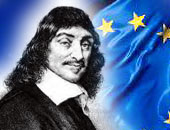
[2007-02-06] Am 7. März werden in Brüssel die Gewinner des diesjährigen Descartes-Preises bekannt gegeben. Unter den Nominierten ist QGATES, ein Projekt zur Quanteninformationsverarbeitung, an dem das Team um Prof. Rainer Blatt federführend beteiligt war. Die erste Teleportation mit Atomen und das erste „Quantenbyte“ waren aufsehenerregende Ergebnisse der erfolgreichen internationalen Zusammenarbeit.
Mit dem Descartes-Preis für Forschung zeichnet die Europäische Kommission jedes Jahr die erfolgreichsten transnationalen Forschungsprojekte in Europa aus. Die Auszeichnung wird in diesem Jahr zum insgesamt siebten Mal vergeben und würdigt herausragende wissenschaftliche und technologische Spitzenleistungen in grenzüberschreitender Zusammenarbeit. Der mit 1,15 Million Euro dotierte Preis ist nach dem französischen Philosophen und Mathematiker René Descartes (1596-1650) benannt.
Blick in die Zukunft: Rechnen mit Quanten
Im Forschungsprojekt QGATES schlossen sich 14 Arbeitsgruppen aus Österreich, Deutschland, Frankreich, Großbritannien, der Slowakei und Spanien zusammen, um verschiedene Zugänge für die Quanteninformationsverarbeitung zu erforschen und damit die Grundlagen für einen zukünftigen Quantencomputer zu legen. Die Innsbrucker Experimentalphysiker um Prof. Rainer Blatt konnten hier große Fortschritte erzielen und erstmals einzelne Bausteine und kleine Prototypen eines Quantencomputers im Labor realisieren. Die Forscher fangen dazu ionisierte Atome in Fallen und kühlen sie stark ab. Mit Lasern kontrollieren sie sehr genau den internen Zustand der Atome – ihre Quantenzustände. Auf diese Weise gelang den Wissenschaftlern 2004 die weltweit erste Teleportation mit Atomen – die Übertragung des Zustands eines atomaren Teilchens auf ein zweites Teilchen. Ein Jahr später konnten die Innsbrucker Forscher die Erzeugung des ersten „Quantenbytes“, acht kontrolliert verschränkter Ionen, vermelden. Es gelang ihnen auch, die Verschränkung zweier Teilchen über die Dauer von 20 Sekunden aufrecht zu erhalten. Mit diesen Experimenten haben die Forscher nun Werkzeuge zur Hand, mit denen sie die Prozesse der Quanteninformationsverarbeitung sehr genau studieren können. Das Ziel für die Zukunft lautet, den Quantencomputer skalierbar zu machen, das heißt die erfolgreich erprobten Konzepte auf größere Einheiten auszudehnen. Dazu arbeiten die Forscher bereits in einem neuen europäischen Projekt (SCALA) zusammen.
Internationale Sichtbarkeit
„Ohne die enge Kooperation mit internationalen Partner wären unsere Erfolge nicht möglich“, betont Rainer Blatt. „Durch die erfolgreiche Arbeit in Innsbruck haben wir uns international einen Namen gemacht, der uns zu einem attraktiven Partner für die besten Forschungsgruppen auf diesem Gebiet macht.“ Dies zeigt auch die Tatsache, dass drei frühere Mitglieder der Gruppe Blatt inzwischen auf Professuren in Deutschland und Spanien berufen wurden. „Entscheidend für diese Erfolge ist aber auch die enge Kooperation von Theoretikern und Experimentalphysikern an der Universität Innsbruck, dem von der Österreichischen Akademie der Wissenschaften (ÖAW) eingerichteten Institut für Quantenoptik und Quanteninformation (IQOQI) und dem österreichweiten Spezialforschungsbereich des FWF sowie die Unterstützung durch Land Tirol, Stadt Innsbruck und die Tiroler Industrie“, so Blatt abschließend.